MARIANI’SVirtual
Gourmet
December
8, 2013
NEWSLETTER
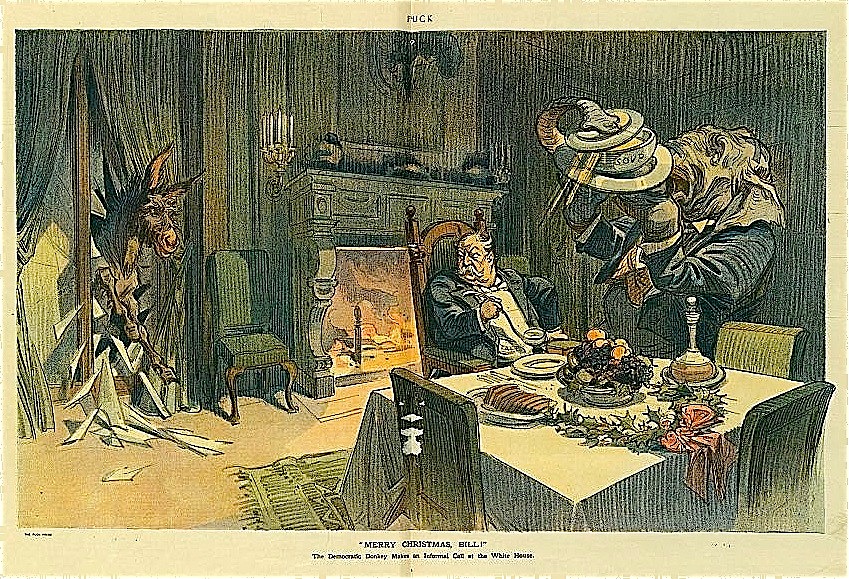
Political Cartoon of Pres. William Howard Taft
(1909-1913) in Puck.
THIS
WEEK
THREE GREAT KITCHEN GIFTS FOR
THE HOLIDAYS
by John Mariani
NEW
YORK CORNER
Dubrovnik
by John Mariani
NOTES FROM
THE WINE CELLAR
A WORLD CLASS CRU FROM SOUTH AFRICA?
by Andrew Chalk
❖❖❖
THREE GREAT KITCHEN GIFTS FOR THE
HOLIDAYS
by John Mariani

Like everyone, I
like a good kitchen gadget that works,
though I’ve never been suckered in by any of those
sold by info-mercials on TV, when, “if you call
now, you get two extra thigamajigs and a whole set
of steak knives for just $29.95 in three easy
payments plus shipping!”
I’ll never be convinced of the importance
of owning a can opener shaped like a toucan
($25) or a wheat grass juicer ($142), and the
microwave oven someone gave me years ago has
never come out of its box.
So when I come across
three items that really impress me for their
utility and as-promised dependability, I want to
tell all my friends who spend any serious time
in the kitchen.
 1. About fifteen years ago,
the great French master chef Alain Ducasse proudly
showed off his ridiculously expensive new induction
range installed in his New York restaurant. He put a
pot of water on the circle, turned it on, and within
30 seconds the water was boiling furiously. He then
told me to touch the cooking surface with the palm of
my hand. Hesitating but dutiful, I did so and found it
cool as glass. Now,
this was a really amazing piece of machinery, but
wholly out of the question—at thousands of dollars—for
a home kitchen.
1. About fifteen years ago,
the great French master chef Alain Ducasse proudly
showed off his ridiculously expensive new induction
range installed in his New York restaurant. He put a
pot of water on the circle, turned it on, and within
30 seconds the water was boiling furiously. He then
told me to touch the cooking surface with the palm of
my hand. Hesitating but dutiful, I did so and found it
cool as glass. Now,
this was a really amazing piece of machinery, but
wholly out of the question—at thousands of dollars—for
a home kitchen.
Then, this summer, I was sent
a demo model of the Waring Pro
Double® Induction Cooktop
($249.95), which looks more or less like a simple hot
plate but is actually every bit as impressive as what
I saw in Ducasse’s kitchen. Weighing only seven pounds, it’s
easy enough to put on your kitchen counter, and its
various settings allow you to instantly modify the
cooking temperature, has a 150-minute timer, and shuts
off automatically 30 seconds after a pot is removed.
And it uses 70 percent less energy than conventional
cooktops.
At first I thought the cooktop a reasonable
alternative or addition to my gas range, but during a
brutally hot July, when I didn’t want to turn on a
flame burner to add to the kitchen’s heat, I used the
induction cooktop relentlessly, with the only heat
coming from the food being cooked.
One caveat: it only works with stainless steel
pots and pans, so you can’t use your cast iron or
simple aluminum cookware. But I have really learned to
love this novelty, which strikes me as one of the
better inventions of the 21st
century for the home kitchen.
2. As a passionate pizza lover
who demands very specific virtues in how the crust
cooks and the toppings meld, I was hardly impressed
when a NEWWAVE Just
Pizza Oven ($99) arrived at my door,
looking like a countertop kettle barbecue grill. For fun, 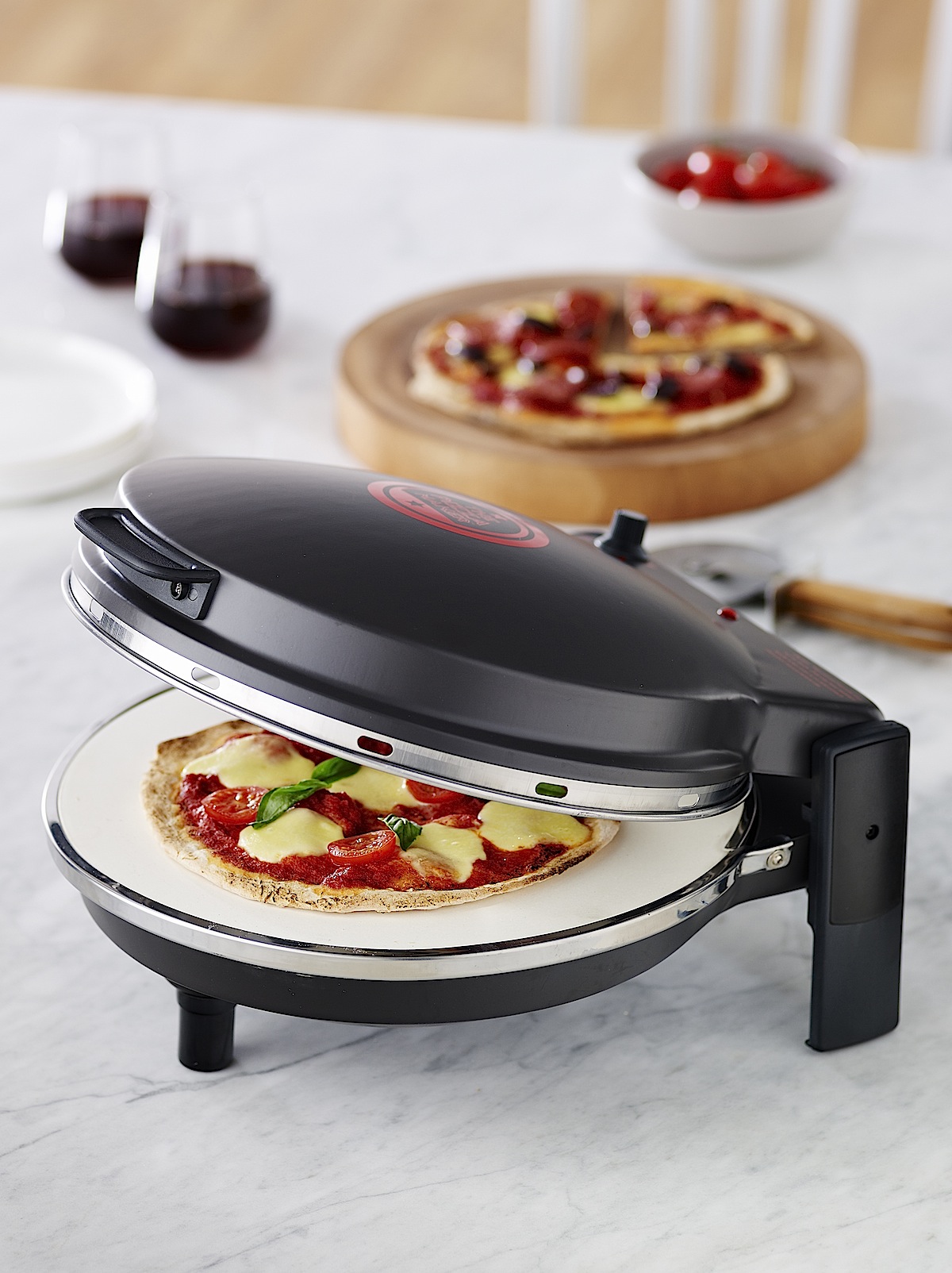 I thought I’d give it a try,
strongly suspecting I would get an anemic-looking,
soft, puffy crust.
I thought I’d give it a try,
strongly suspecting I would get an anemic-looking,
soft, puffy crust.
I bought pizza dough from an Italian bakery,
topped it with various ingredients, and, after heating
up the Pizza Maker as instructed for five minutes,
slid it onto the stone. Five minutes later out came as
perfect a pizza as I’ve ever made at home—the crust
was crispy, slightly charred underneath, and had those
glorious charred bubbles of dough around the
circumference (which Italians call the “cornicione”). It was
easily as good as some my favorite pizzerias make.
(The photo on the right doesn't really show the
blistery beauty of the real thing.)
Had I made this pizza in my regular gas or
electric oven, I would have had to heat up a pizza
stone at the highest heat attainable (only about 450
degrees) for an hour before putting the pizza on it,
then cooking it, shifting it around in the process,
for about 15 minutes.
The Pizza Maker reached a much higher,
controlled temperature in five minutes, evenly
throughout, so I didn't need to shift the pie around.
I was so impressed that I was making pizzas
every night and even for breakfast, with a spread of
Nutella hazelnut and chocolate. Now, that’s a
nutritious breakfast!
3. 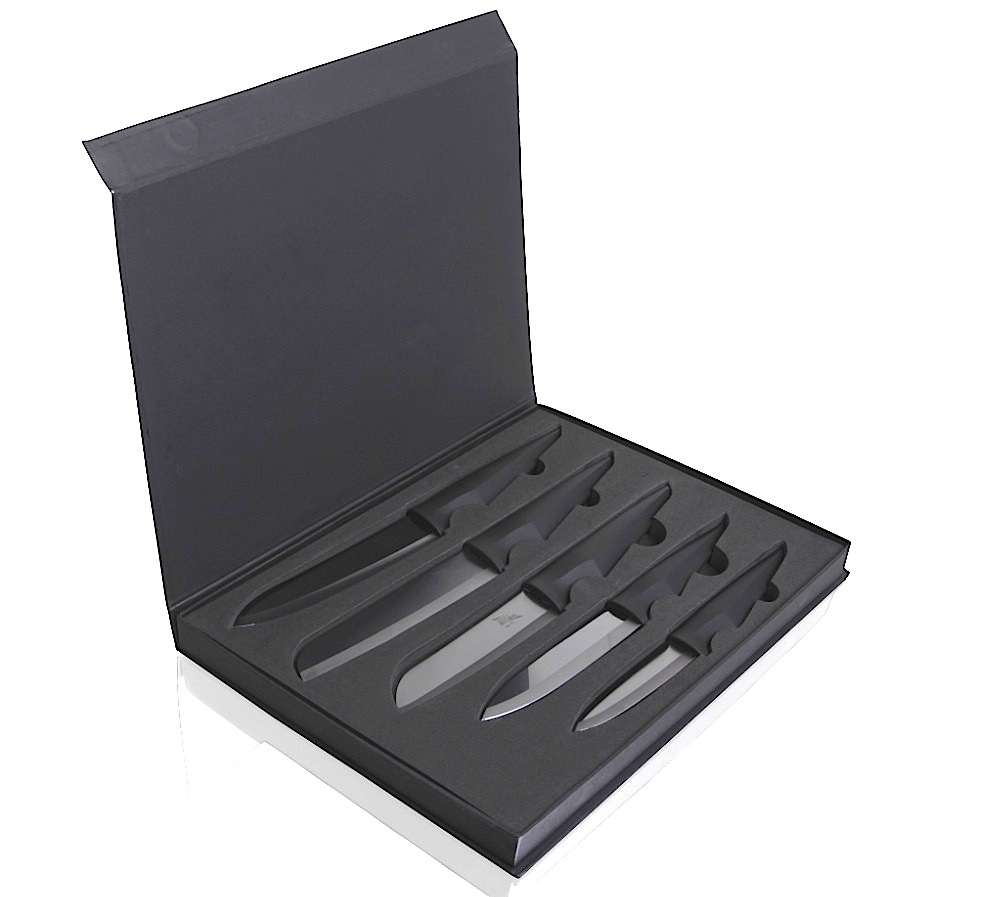 I’ve never used
ceramic knives in the kitchen because those I
have tested chipped and broke easily and didn't keep
the sharp edge promised. Professional
chefs spurn them with utter disdain. Then I
tried out a new, state-of-the-art set of ceramic
knives, created by London designer Edge of
Belgravia, which are incredibly
sharp—made from zirconium oxide forged under 300 tons
of pressure at a temperature of 1,400° F and said
to be much sharper for much longer than steel blades.
I’ve never used
ceramic knives in the kitchen because those I
have tested chipped and broke easily and didn't keep
the sharp edge promised. Professional
chefs spurn them with utter disdain. Then I
tried out a new, state-of-the-art set of ceramic
knives, created by London designer Edge of
Belgravia, which are incredibly
sharp—made from zirconium oxide forged under 300 tons
of pressure at a temperature of 1,400° F and said
to be much sharper for much longer than steel blades.
They are terrific looking—the
black ones look like Ninja knives, though the lime
green ones are merely pretty—and though light in the
hand, I found them so sharp that, without being
serrated, they cut with surgical precision through
tomatoes and the tough rinds of limes in one movement. You can buy
the knives individually—slicer ($107.90), chef’s knife
($92.90), santoku ($76.90), utility ($76.90) and
paring ($44.90)—or as a set ($399.50).
Chefs who
spend hours chopping and slicing may contend that they
prefer more heft and weight in their knives, but I
found the slicing so easy and consistent, and I can't
imagine any home cook slicing up 200 zucchini.
~~~~~~
NEW YORK CORNER
by John Mariani
Dubrovnik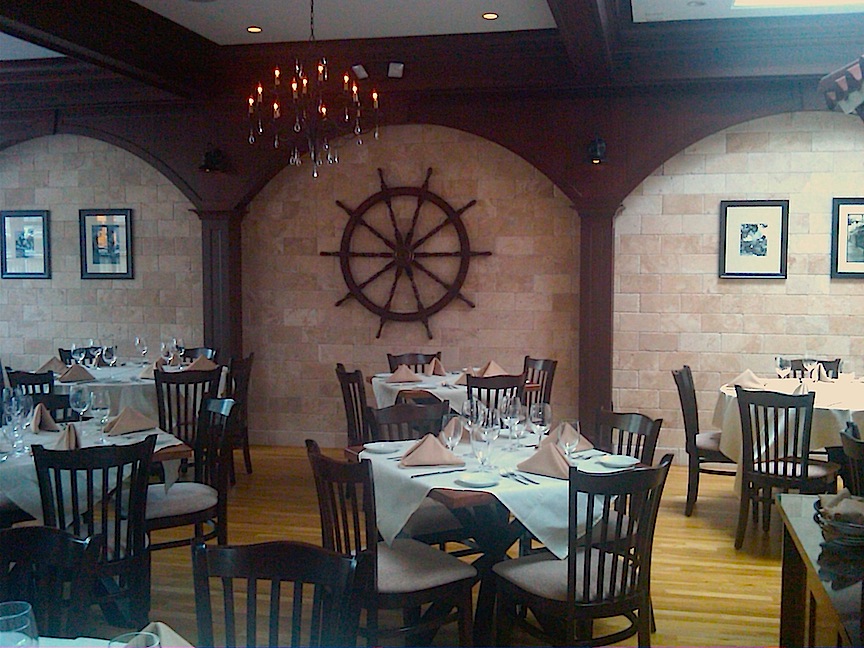
721
Main Street
New Rochelle,
NY
914-637-3777
www.dubrovnikny.com
I have not (yet) visited the Dalmatian
Coast, which I hear so many wonderful things about—the
ruggedness of the seaside, the stretching away of the
dark Adriatic, the small villages and a cuisine that
takes full advantage of its location, not least for a
great array of seafood. I am already an admirer of
modern Croatian wineries.
So the opening of Dubrovnik not far
from where I live in Westchester County (about a
45-minute drive from midtown Manhattan) was wholly
enticing to me. Set along a less-than-lovely
stretch of New Rochelle, NY, the restaurant’s colorful
façade declares owner Jerry Tomic’s intention
to make you feel very, very welcome. Once inside, you
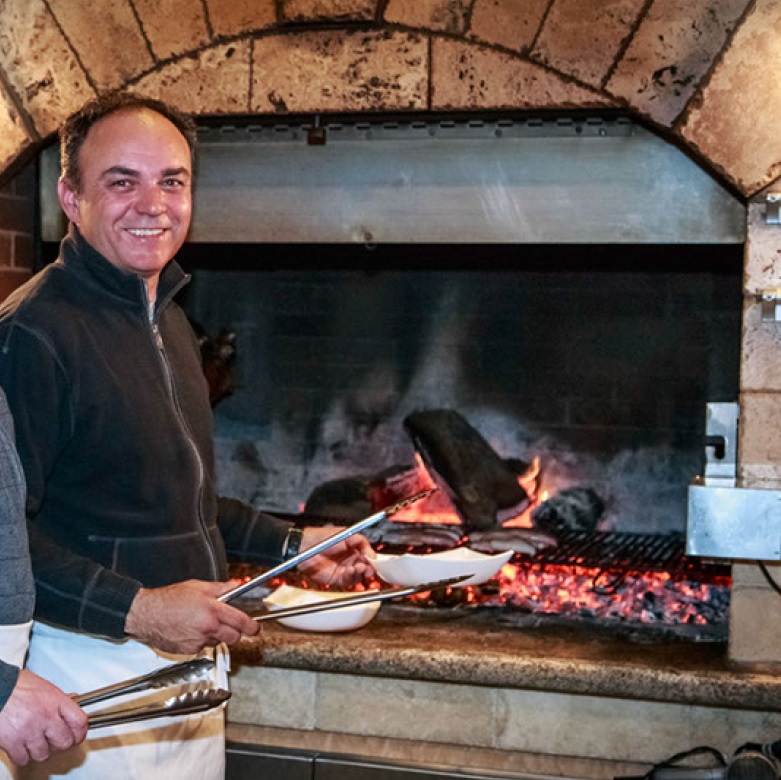 will be heartily greeted and
shown to a linen-draped table in a room of
considerable warmth, especially now with the fire and
rotisserie going strong. There is a good bar, though
not as well stocked as it might be, but there are some
Croatian-style spirits well worth trying as
after-dinner drinks.
will be heartily greeted and
shown to a linen-draped table in a room of
considerable warmth, especially now with the fire and
rotisserie going strong. There is a good bar, though
not as well stocked as it might be, but there are some
Croatian-style spirits well worth trying as
after-dinner drinks.
The dining room décor evokes
the seaside restaurants of the coastal city, with a
ship’s wheel on a wall arched with dark polished wood
(Tomic [left]
also owns Top Drawer Custom Cabinetry in town). There
are petite chandeliers, sheer white draperies, and
evocative black-and-white photos of Croatia along the
walls. The lighting is very homey, the clientele
appears to be very happy to be among friends, and the
staff does everything to make their guests’ evening go
right.
Out back is a considerable garden
and patio with fountain (below) that will be put to good use
come springtime. There is a lot of space highly
suitable for parties here, and Dubrovnik gets a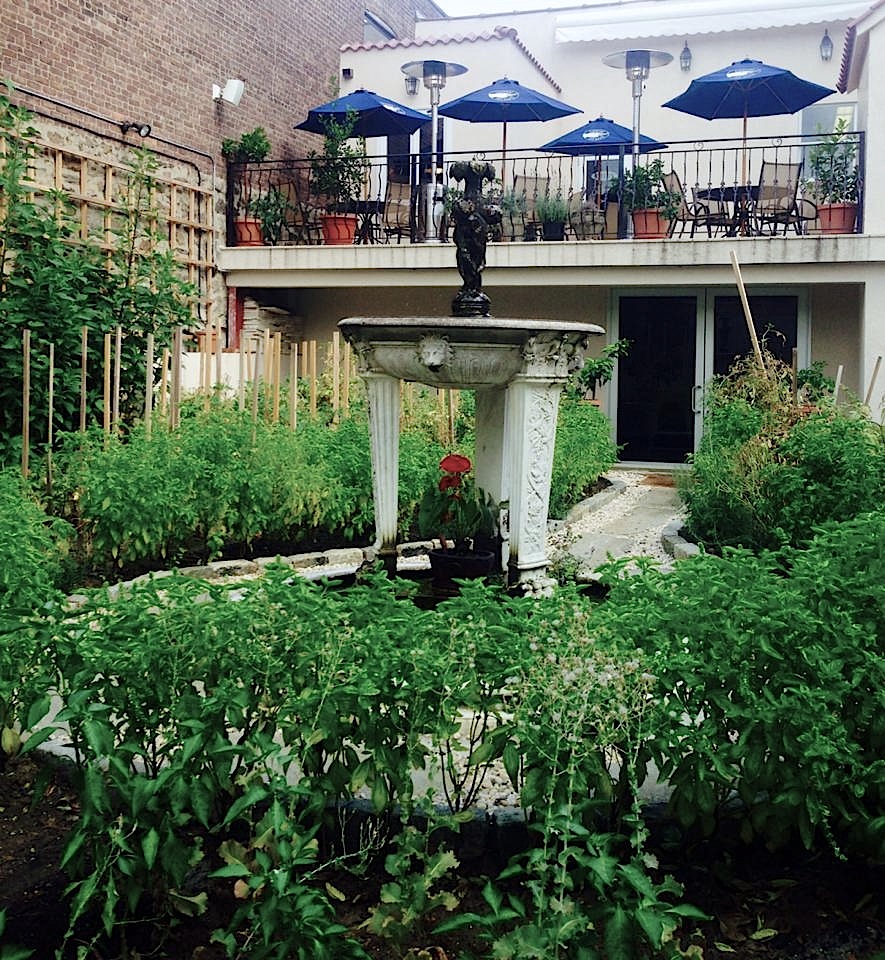 local Croatian crowd for
celebratory events.
local Croatian crowd for
celebratory events.
So,
everything seemed set for a congenial evening with
friends, though I wondered how good the food might
really be, when shortcuts might be so easily taken on
a menu whose prices are so remarkably modest.
But when the manager brought out a lavish
platter of obviously very fresh seafood—octopus,
shrimp, red snapper, dorade, bream, cod, tuna, and
whatever was of the highest quality in the market that
morning—I realized immediately that Dubrovnik takes
its food very seriously.
Indeed, what I ate that night was
some of the finest seafood I’ve found anywhere in this
country, where I am so often disappointed in quality
even at very expensive restaurants. Of course,
you can have good product, but if you don’t know how
to cook seafood, it won’t matter in the least. At
Dubrovnik each species came roasted or from the grill
cooked to impeccable succulence, the fish firmly
textured but easy to slide from the bones, simply
dressed with nothing more than good olive oil and
lemon.
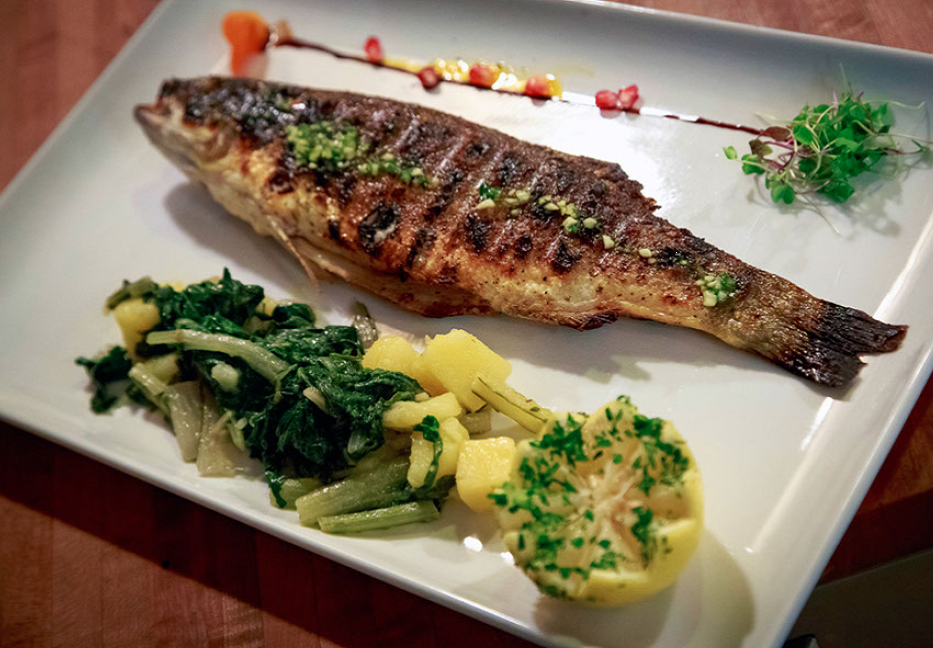 You may begin
with poached shrimp with a cocktail sauce—nothing out
of the ordinary except that the shrimp were fat, juicy
and full of flavor. The octopus salad was
perfectly cooked, spiced up with capers, tangy red
onions, boiled potatoes, olive oil and vinegar—a good
way to get the appetite roaring. Even more impressive
were some large calamari served whole, not cut up, not
fried, and the flavor of the sea was briny and
delicious.
You may begin
with poached shrimp with a cocktail sauce—nothing out
of the ordinary except that the shrimp were fat, juicy
and full of flavor. The octopus salad was
perfectly cooked, spiced up with capers, tangy red
onions, boiled potatoes, olive oil and vinegar—a good
way to get the appetite roaring. Even more impressive
were some large calamari served whole, not cut up, not
fried, and the flavor of the sea was briny and
delicious.
There were two pastas on the menu,
which makes sense since both Croatia and Italy share
the Adriatic between them and a long history of
culinary interaction. So I was not surprised to find a
dish called teletina
na lovački (gnocchi with a rich veal
ragù) much to my liking, as was pasta sa povrčem
(with a complex vegetable sauce).
If you are in
the mood for lamb, which throughout Eastern Europe is
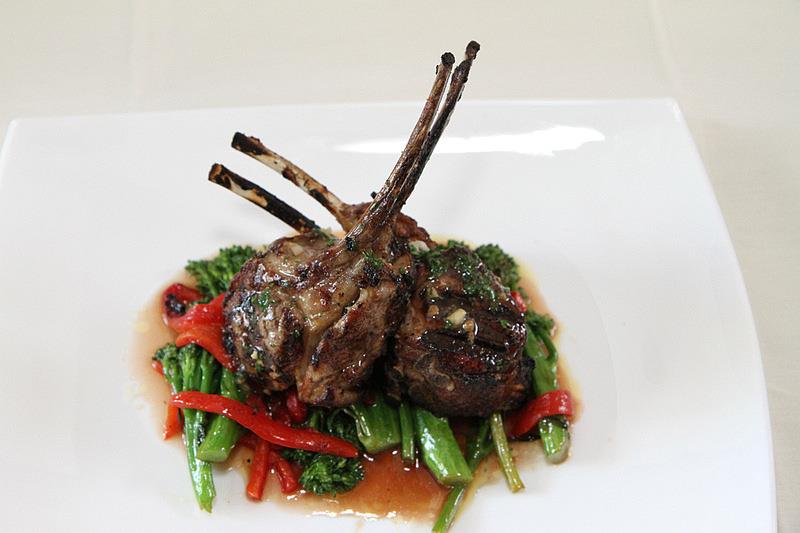 far more
popular than beef, by all means try Dubrovnik’s lamb
chops “nona,”
sizzling hot from the grill, tingling with rosemary
and garlic sauce and served with broccolini and sweet
roasted peppers (right).
The portion of chops--four thick ones--is
enormous and you’ll undoubtedly take some home, as I
did. Svinjski
kotlet Dubrovnki is a roasted pork loin, nicely
fatted, stuffed with prosciutto and onion, just the
right dish for the oncoming winter cold.
far more
popular than beef, by all means try Dubrovnik’s lamb
chops “nona,”
sizzling hot from the grill, tingling with rosemary
and garlic sauce and served with broccolini and sweet
roasted peppers (right).
The portion of chops--four thick ones--is
enormous and you’ll undoubtedly take some home, as I
did. Svinjski
kotlet Dubrovnki is a roasted pork loin, nicely
fatted, stuffed with prosciutto and onion, just the
right dish for the oncoming winter cold.
For dessert I’m sure you’ll delight
in the palacinke,
light, lacy crêpes filled with
chocolate-hazelnut Nutella.
The wine list is nothing to rave
about and has, for the moment, too few Croatian wines,
but those they do carry, like the Piližota Babic 2011,
are impressive bottlings that go very well with this
kind of food.
For the authenticity of Dubrovnik’s
setting and cooking, it would be a restaurant anyone
with a love of good seafood and lamb should hurry to,
but add in such a large component of hospitality, and
you have a restaurant you will return to as an old
friend of the house after one visit.
The restaurant is open 7 days a week for lunch and dinner. Appetizers, soups and salads: $5.75 to $15.75; main courses: $18.75 to $34.75.
❖❖❖
NOTES FROM THE WINE
CELLAR
SOUTH AFRICAN
WINERY AIMS FOR A WORLD-CLASS CRU
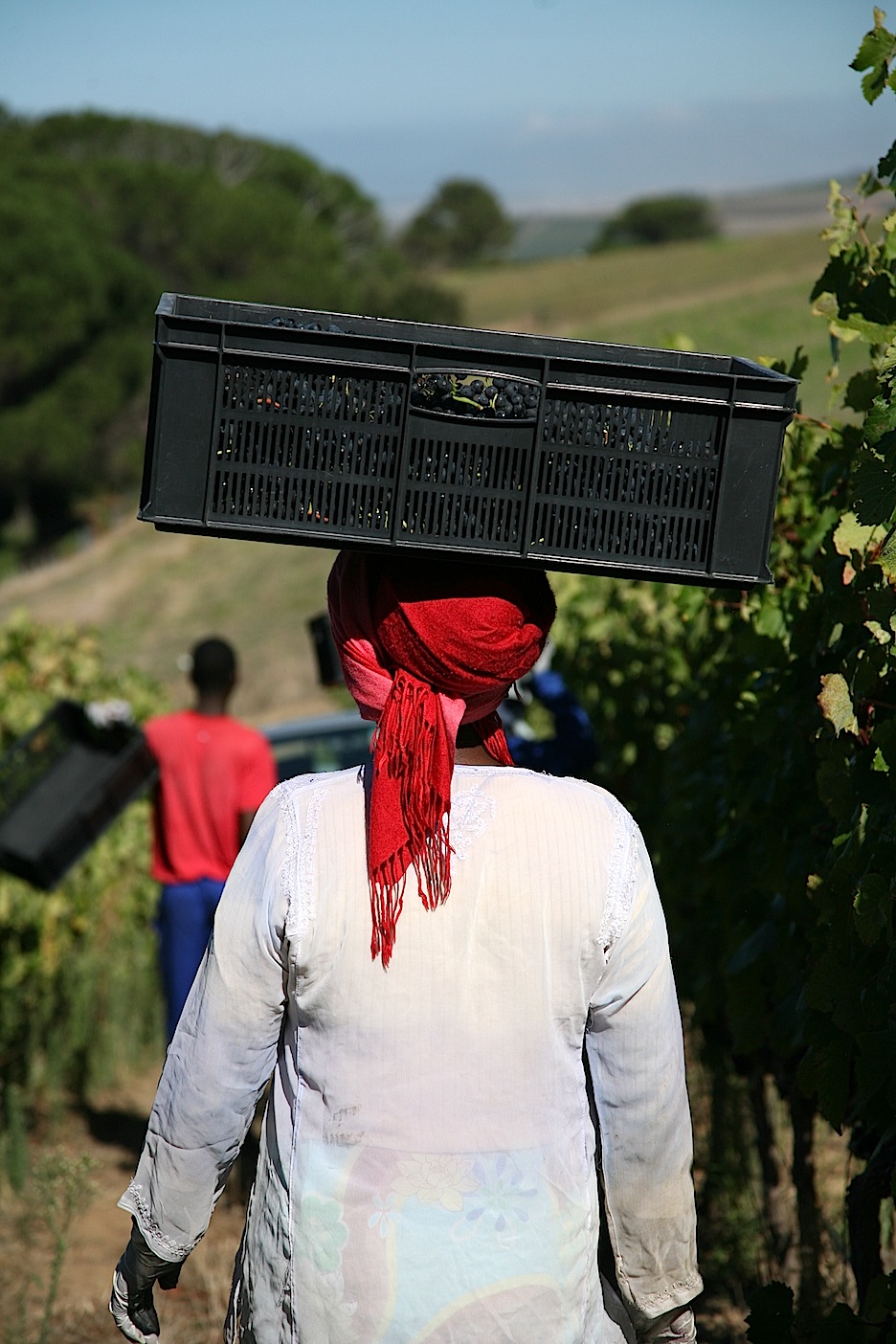 Since the onset
of the modern South African wine industry in
1994, there has failed to emerge a dry red table
wine that is mentioned in the same breath as the
great Cabernet/Shiraz red wines of the world like
Bordeaux Crus, Australia’s Grange and California’s
cult Cabernets. That should change if an
international consortium of oenological and
business talent has its way.
Since the onset
of the modern South African wine industry in
1994, there has failed to emerge a dry red table
wine that is mentioned in the same breath as the
great Cabernet/Shiraz red wines of the world like
Bordeaux Crus, Australia’s Grange and California’s
cult Cabernets. That should change if an
international consortium of oenological and
business talent has its way.
4G Wine Estate
was established in 2009 by Swiss business consultant
Phillipp Axt, French Bordeaux University professor
and super-consultant Denis Dubourdieu (below, sorting grapes),
Italian-born South African winemaker Giorgio Dalla
Cia (below, with
Mia Fischer) the man who made Rubicon at
Meerlust) and other investors. Its mission statement
is the easiest thing to convey: to make the best
wine in South Africa that is also of world class
quality, without regard to cost. A so-called First
Growth of The Cape. Its name is ‘G.’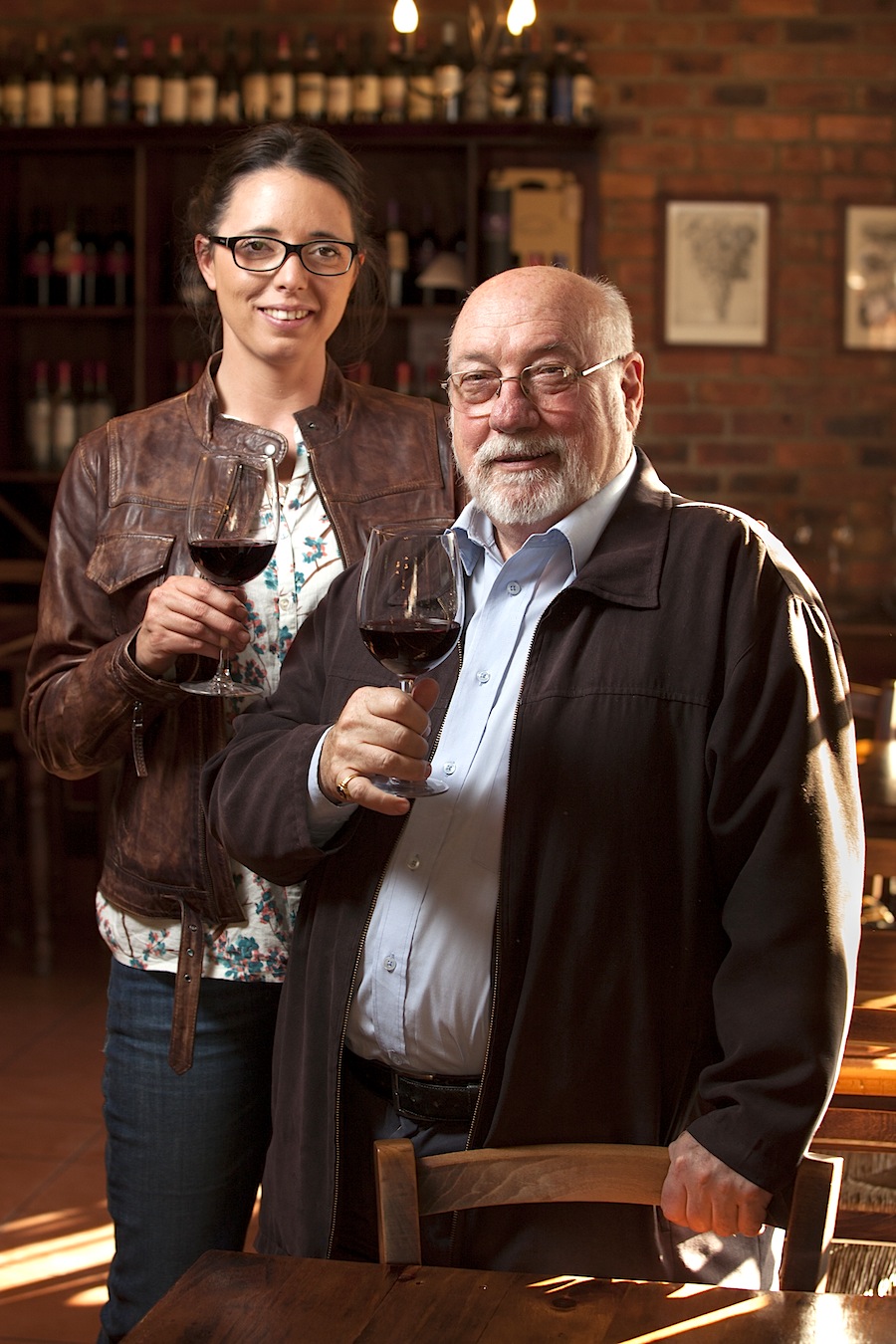
They hired onsite winemaker Mia Fischer, a graduate
of South Africa’s Elsenberg Agricultural College
with experience in Germany, France and New Zealand,
and set about using some unusual and, at least in
South Africa, unprecedented practices to make the
wine. To put that in context: in the grape growing,
the best vineyard sites were selected and then the
selection narrowed down to the best rows of vines in
those vineyards. Those were then leased from the owner, just
for the vintage. The lease stipulated that the owner
could do no agricultural work on the vines for that
vintage season. 4G would do it all, providing its
own workers, tools and management. At the end of the
growing season 4G would harvest the grapes, the
lease would end, and the maintenance revert to the
owner.
De-stemming is done by hand. The grapes are then
individually sorted by hand, a process that requires
more than 100 employees. After fermentation
(both barrel and steel is used, the proportion
varying by vintage), the wine is aged 18 months in
100 percent new French oak (multiple cooperages have
been tried), after which it is bottled in what I can
vouch are the heaviest 750ml wine bottles I have
ever lifted, each one empty clocking the scales at
more than four pounds.
To complete the packaging tour de force, each bottle
gets an ornate 50-layer gallery resolution printed
label by young German artist Sebastian Blinde
on which an African Sea Eagle bristles in front of a
matte black “G.” When you package like this, the
contents have a lot to live up to.
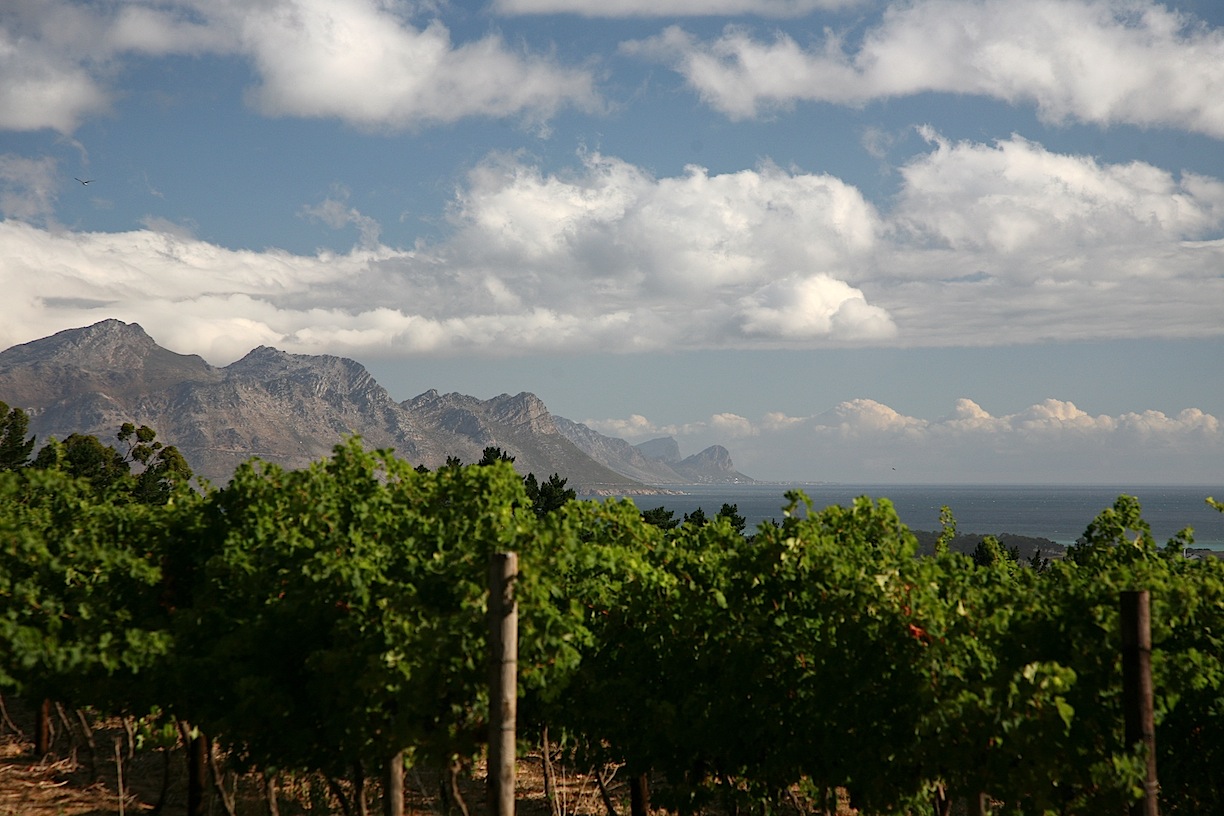 The
2009 vintage produced 2,915 bottles of a prototype of
G that was given away to friends and family. The first
released vintage of G was the 2010, which turned out
3,410 bottles. The cépage was 59% Cabernet
Sauvignon, 26% Shiraz, 12% Merlot, 3% Cabernet Franc.
This makes for a wine that has a nose of dark fruit
(black currant, blueberries) and lead pencil with
hints of oak. After aeration, it opens up to forest
floor notes. In the mouth it is still tight.
The
2009 vintage produced 2,915 bottles of a prototype of
G that was given away to friends and family. The first
released vintage of G was the 2010, which turned out
3,410 bottles. The cépage was 59% Cabernet
Sauvignon, 26% Shiraz, 12% Merlot, 3% Cabernet Franc.
This makes for a wine that has a nose of dark fruit
(black currant, blueberries) and lead pencil with
hints of oak. After aeration, it opens up to forest
floor notes. In the mouth it is still tight.
Only 1,943 bottles of the 2011 were
produced and the cépage was modified to
Cabernet Sauvignon, Shiraz, Merlot, and Petit- Verdot
(4g does not publish percentages here on out; I do not
know why). The 2011 initially seemed grapey in the
nose, its raspberry and black cherry fruit not as
intense as 2010. There was some five spice powder.
Over time it revealed a very complex nose. In the
mouth there were pronounced anthocyanins, hints of
cedar, and a long cedar-y finish. It opens up with
time and the fruit becomes very powerful. Overall, not
quite as polished as 2010, but that may reflect its
youth. 
The winery also produces a second
wine, “Echo of G” (not tasted), reflecting lots not
blended into G.
Each bottle of G is individually
numbered and owners may enter their bottle numbers
into a registry on the 4G website. This should help
owners prove their bottles are genuine, if they plan
to transfer them to new owners at a later date (if 4G
Wines runs the registry properly). It is interesting,
and fair, to consider both vintages and ask what
common characteristics is G establishing. Both these
wines are undoubtedly new world wines. In terms of
parallels with other greats they most closely resemble
Napa cult Cabernets.
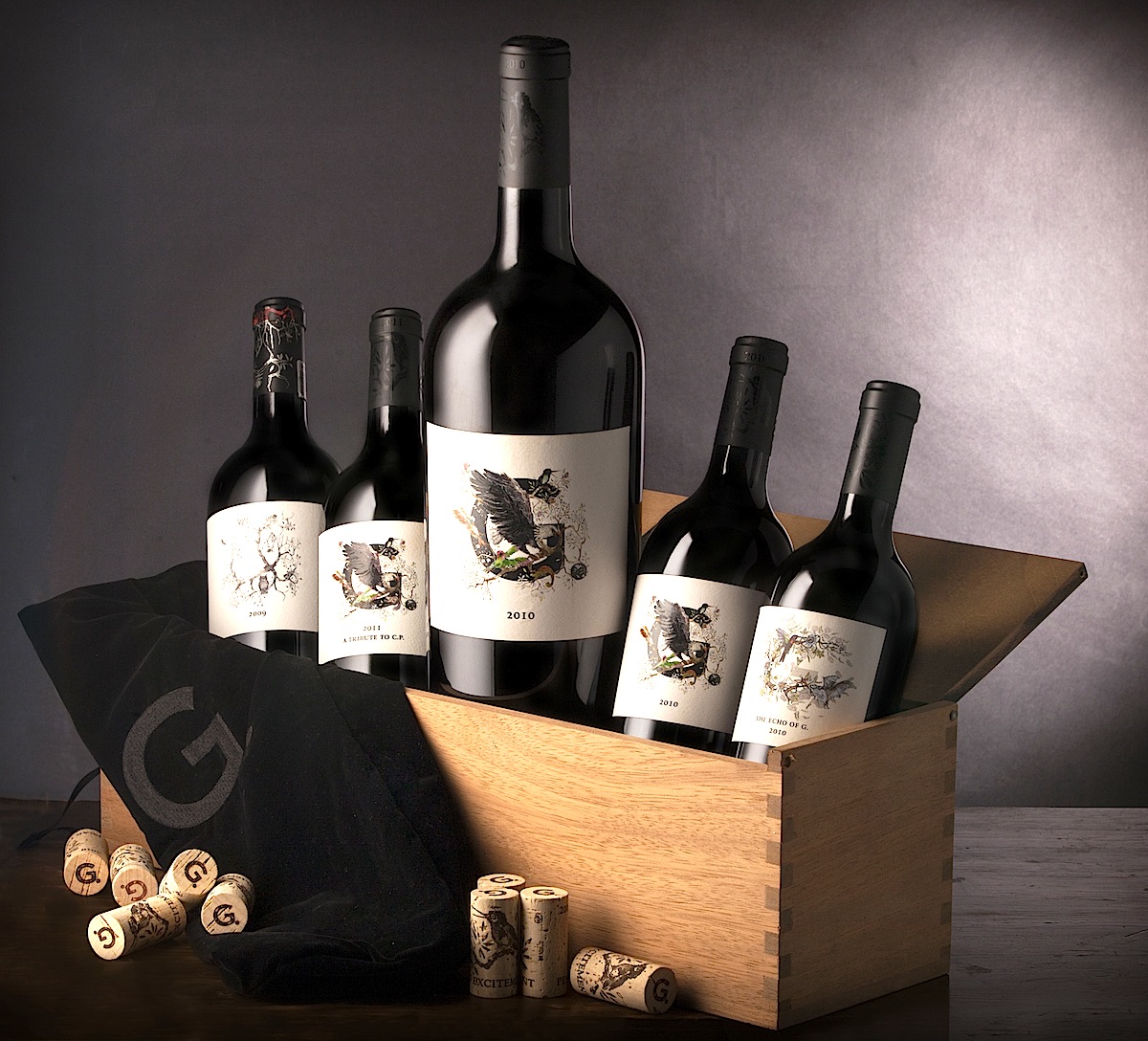 It
is too early to talk about ageability in anything more
than a predictive sense. Sure, the backbone will mean
ageability for a decade or more, but how long, and how
the wine will evolve is a more open question.
It
is too early to talk about ageability in anything more
than a predictive sense. Sure, the backbone will mean
ageability for a decade or more, but how long, and how
the wine will evolve is a more open question.
The jury is also out on whether
this is a First Growth of The Cape for another reason.
The house style is still under development. Look at
the omission of Cabernet Franc and its replacement
with Petit-Verdot between 2010 and 2011. No
established growth would make such a huge change in
the blend because the experiments were done long ago
and the house style settled. With G, by contrast, we
have a wine that is still in development.
Perhaps the hardest goal for the 4g
team will be giving G a sense of place. Bordeaux and
Grange carry the leitmotifs of their regions.
California Cabernet lucked out being the first global
star to stake a claim to massive Cabernet fruit as its
defining characteristic. G arrives last and finds the
ballroom already crowded.
None of this detracts from the fact
that this is a wonderful wine and the proprietors are
doing all of the right things to get it its place
among the great growths. Keep a careful eye on this
wine as it may hit the G spot sometime in the future.
G.2011 goes on sale next month in
the United States at a suggested retail price of $360.
Andrew Chalk is a
Dallas-based writer on wine, food and
travel. He is editor of CraveDFW.com and senior
writer for "Texas Wine & Trail."
❖❖❖
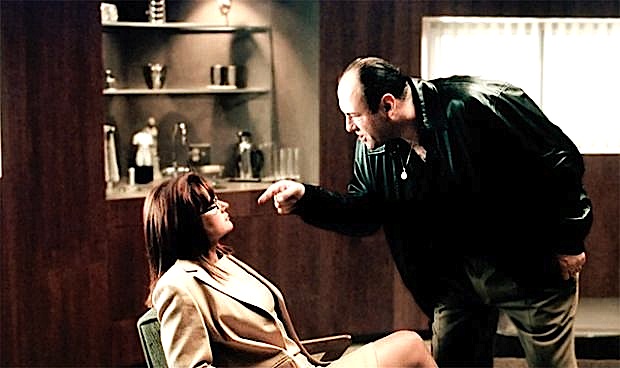
SO YOU HAVE ONLY BULLET IN YOUR GUN.
WHOM
DO YOU SHOOT, THE KID OR THE SHRINK?
An Upper
East Side, NYC father named David Schnorr has
sued a court-appointed psychiatrist after she
testified in a child custody case that his refusal to
treat his 4-year old to McDonald's was an example of "unfit
parenting." Mr. Schorr told his son to
choose any restaurant NYC except McDonald's, or
no dinner at all. The son chose no dinner. The
psychiatrist told the court that Schorr was
"wholly incapable of taking care of his son."
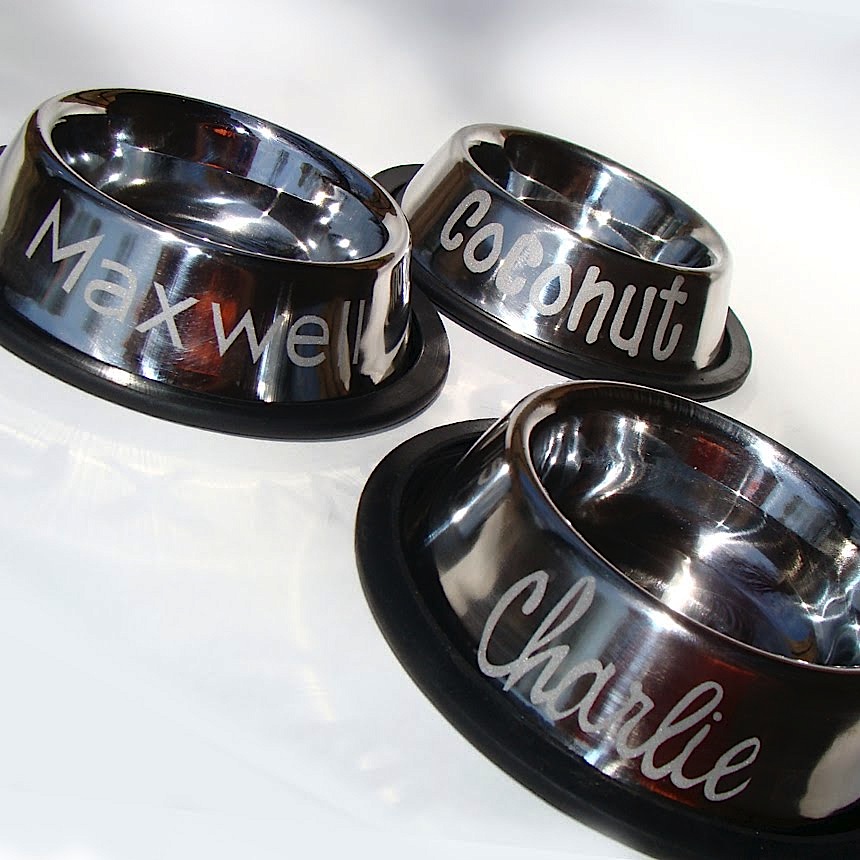
"We
have talked before about the gentrification of deep
downtown, the colorful area familiar from dystopian
novels and Tom Waits lyrics that has become the most
reliable destination in town for bespoke cocktails,
vintage party dresses and monogrammed dog bowls."--
❖❖❖
QUICK BYTES
Countywide Service
Excellence Workshops
 Eric Weiss, who has been teaching people
the art of service since 1994, has steadily broadened
his reach, training the staffs of restaurants,
resorts, hotel groups, then in 2012 an entire
city—Healdsburg, California—and in 2013 an entire
California county, Mendocino. In the new year he will
present Countywide Service Excellence Workshops in
Sonoma and Napa in January and April.
Eric Weiss, who has been teaching people
the art of service since 1994, has steadily broadened
his reach, training the staffs of restaurants,
resorts, hotel groups, then in 2012 an entire
city—Healdsburg, California—and in 2013 an entire
California county, Mendocino. In the new year he will
present Countywide Service Excellence Workshops in
Sonoma and Napa in January and April.
“In Mendocino, the challenge was
the mountains that separate the coast from the
inland,” Weiss reflects. “We focused on team building
and getting people from different areas of the county
together. “Sonoma and Napa are different. Napa
has been riding for decades on the idea it can do no
wrong. Now it recognizes it needs to do more. Sonoma
has always been regarded as Napa’s little sister. But
Sonoma has moved into first place in Trip Advisor as
the Number One visited wine region in the world—over
Tuscany, Bordeaux, you name it. So Napa is looking
over its shoulder, and Sonoma wants to maintain its
position.”
Daniel Shanks, director of food
& beverage and events at the White House, has
called the Countywide
Service
Excellence Workshops “an
initiative that could change the face of
hospitality.” Michael Bauer, restaurant critic
of the San
Francisco Chronicle, recently hailed the
Countywide Workshops as “an ambitious and grand idea.
Anyone who travels to the wine country knows it’s hard
to find exceptional staff.”
Both workshops will take place over
several days, divided into daily sessions from 9 am to
4 pm, with a 45-minute break for lunch. The Sonoma
workshop will be held at Safari West, a 400-acre
private wildlife preserve in Santa Rosa. The location
of the Napa workshop has yet to be determined.
The January sessions will be spread
over five days. The
first two days will be for lodgings and restaurants,
the next two days for wineries. All
participants will come together on the final day for a
wrap-up. April’s workshop will be a seven-day affair:
Lodgings and restaurants the first two days, wineries
the next two days, then two days for independent
services (civic leaders, banks, markets, boutiques,
utilities, etc.) and a one-day wrap-up with everyone
together.
Presenting in partnership with
Weiss will be the West Coast representative of Service
Excellence Citywide, Maureen
“Mo” McElroy, “Sonomambassador” and chief service
officer for I AM Your Destination.
Registration is limited to 45
participants per business sector. For details, visit www.servicecitywide.com
Any of John Mariani's
books below may be ordered from amazon.com.
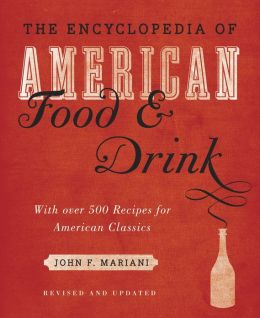 |
THE ENCYCLOPEDIA OF AMERICAN FOOD & DRINK by John F. Mariani (Bloomsbury USA, $35)—This Fifth edition of this classic American reference work updates more than a decade of what has happened in our country’s gastronomy, including the rise of sustainable food, locavorism, molecular cuisine, TV food shows and changes in diet and consumption. Most important, for the first time since publication in the 1980s, the book includes more than 100 biographies of Americans who have changed the way we cook, eat and drink, from Fannie Farmer and Julia Child to Robert Mondavi and Thomas Keller. Word origins have been completely updated, as have per capita consumption and production stats. “Filled with information to intrigue and inform.”—The New York Times. “Much needed in any kitchen library.”—Bon Appetit. “Required reading.”—The Dallas Morning News. |
"Eating Italian will never be the same after reading John Mariani's entertaining and savory gastronomical history of the cuisine of Italy and how it won over appetites worldwide. . . . This book is such a tasteful narrative that it will literally make you hungry for Italian food and arouse your appetite for gastronomical history."--Don Oldenburg, USA Today. "Italian
restaurants--some good, some glitzy--far
outnumber their French rivals. Many of
these establishments are zestfully described
in How Italian Food Conquered the World, an
entertaining and fact-filled chronicle by
food-and-wine correspondent John F.
Mariani."--Aram Bakshian Jr., Wall Street
Journal.
"Equal parts
history, sociology, gastronomy, and just
plain fun, How Italian Food Conquered the
World tells the captivating and delicious
story of the (let's face it) everybody's
favorite cuisine with clarity, verve and
more than one surprise."--Colman Andrews,
editorial director of The Daily
Meal.com. "A fantastic and fascinating
read, covering everything from the influence
of Venice's spice trade to the impact of
Italian immigrants in America and the
evolution of alta cucina. This book will
serve as a terrific resource to anyone
interested in the real story of Italian
food."--Mary Ann Esposito, host of PBS-TV's
Ciao
Italia. "John Mariani has written the
definitive history of how Italians won their
way into our hearts, minds, and
stomachs. It's a story of pleasure over
pomp and taste over technique."--Danny Meyer,
owner of NYC restaurants Union Square Cafe,
Gotham Bar & Grill, The Modern, and
Maialino.
|
 |
 |
 |
 |
 |
 |
 |
 |
 Everett Potter's Travel Report:
Everett Potter's Travel Report: 
 Eating Las Vegas
is the new on-line site for Virtual Gourmet
contributor John A. Curtas., who since 1995
has been commenting on the Las Vegas food
scene and reviewing restaurants for Nevada
Public Radio. He is also the
restaurant critic for KLAS TV, Channel 8 in
Las Vegas, and his past reviews can be
accessed at KNPR.org.
Click on the logo below to go directly to
his site.
Eating Las Vegas
is the new on-line site for Virtual Gourmet
contributor John A. Curtas., who since 1995
has been commenting on the Las Vegas food
scene and reviewing restaurants for Nevada
Public Radio. He is also the
restaurant critic for KLAS TV, Channel 8 in
Las Vegas, and his past reviews can be
accessed at KNPR.org.
Click on the logo below to go directly to
his site.

Tennis Resorts Online: A Critical Guide to the World's Best Tennis Resorts and Tennis Camps, published by ROGER COX, who has spent more than two decades writing about tennis travel, including a 17-year stretch for Tennis magazine. He has also written for Arthur Frommer's Budget Travel, New York Magazine, Travel & Leisure, Esquire, Money, USTA Magazine, Men's Journal, and The Robb Report. He has authored two books-The World's Best Tennis Vacations (Stephen Greene Press/Viking Penguin, 1990) and The Best Places to Stay in the Rockies (Houghton Mifflin, 1992 & 1994), and the Melbourne (Australia) chapter to the Wall Street Journal Business Guide to Cities of the Pacific Rim (Fodor's Travel Guides, 1991).


MARIANI'S VIRTUAL GOURMET
NEWSLETTER is published weekly. Editor/Publisher: John
Mariani.
Contributing Writers: Christopher Mariani, Robert Mariani,
John A. Curtas, Edward Brivio, Mort Hochstein,
Suzanne Wright, and Brian Freedman. Contributing
Photographers: Galina Stepanoff-Dargery,
Bobby Pirillo. Technical Advisor: Gerry McLoughlin.
© copyright John Mariani 2013
